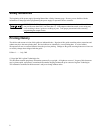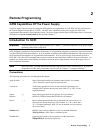10 Remote Programming
SCPI Messages
There are two types of SCPI messages, program and response.
• A program message consists of one or more properly formatted SCPI commands sent from the controller to
the power supply. The message, which may be sent at any time, requests the power supply to perform some action.
• A response message consists of data in a specific SCPI format sent from the power supply to the controller.
The power supply sends the message only when commanded by a special program message called a "query."
Types of SCPI Commands
SCPI has two types of commands, common and subsystem.
Common Commands
Common commands (see Figure 3-1) generally are not related to specific operation but to controlling overall power supply
functions, such as reset, status, and synchronization. All common commands consist of a three-letter nmemonic preceded
by an asterisk:
*RST *IDN? *SRE 8
Subsystem Commands
Subsystem commands (see Figure 3-2) perform specific power supply functions. They are organized into an inverted tree
structure with the "root" at the top. Some are single commands while others are grouped under other subsystems.
Structure of a SCPI Message
SCPI messages consist of one or more message units ending in a message terminator. The terminator is not part of the
syntax, but implicit in the way your programming language indicates the end of a line (such as a newline or end-of-line
character).
The Message Unit
The simplest SCPI command is a single message unit consisting of a command header (or keyword) followed by a message
terminator.
ABOR
VOLT?
The message unit may include a parameter after the header. The parameter usually is numeric, but it can be a string:
VOLT 20
VOLT MAX
Combining Message Units
The following command message (see Figure 2-1) is briefly described here, with more details in subsequent paragraphs.
VOLT:LEV 4.5;PROT 4.8;:CURR?<NL>


















